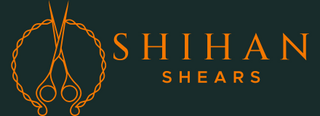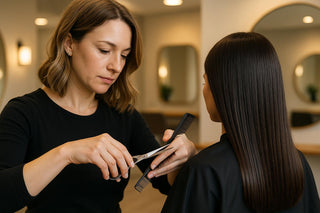Healthy hair starts with precise cuts, the right tools, and proper care. Whether you're a stylist or caring for your own hair, here’s what you need to know:
- Use High-Quality Shears: Japanese steel shears provide clean, damage-free cuts.
- Master Cutting Techniques: Blunt cuts, layering, and texturizing improve hair health and style.
- Stick to a Trim Schedule: Regular trims (every 6–12 weeks) prevent split ends and maintain shape.
- Care for Your Tools: Clean, oil, and sharpen shears regularly to ensure precision.
- Educate Clients: Offer tailored aftercare tips for healthier hair between appointments.
Quick Tip: Hair grows about 1 cm per month, so regular maintenance is key for strong, shiny hair. Ready to learn the details? Let’s dive in!
101: Learning the Basics of Haircutting | Kenra Professional

Core Hair Cutting Methods
Learn key cutting techniques to keep hair healthy and achieve precise, long-lasting results. These methods work hand-in-hand with proper tool maintenance and client aftercare routines.
Clean Line Cutting
Getting a clean cut starts with proper scissor positioning. Hold professional shears at a 90-degree angle for blunt cuts to ensure sharp, damage-free results. Sharp blades and steady hands are essential. To make the process easier, section the hair into smaller, manageable parts using clips. Once the clean cut is done, layering can help balance the hair's weight.
Layering for Hair Balance
Layering builds on clean cuts to shape the hair’s texture and volume. It’s important to adjust the approach based on the client’s hair type and density.
- Vertical Layering: Ideal for thick, heavy hair, this method creates soft, flowing layers while preserving length.
- Graduated Layering: Adds volume and weight structure, resulting in defined, shaped styles.
Texture Cutting: Points vs. Slides
To enhance texture, two main techniques are commonly used:
- Point Cutting: This involves cutting into the hair at a 45-degree angle. It softens the ends, reduces bulk, and keeps the length intact.
- Slide Cutting: A gentle gliding motion is used along the hair shaft while slightly closing the shears. This creates smooth, blended layers and a seamless flow.
Always ensure tools are sharp and in good condition. Work in small sections, and regularly check for balance to maintain a polished result.
Professional Cutting Tools
Maintaining healthy hair starts with using top-tier cutting tools. Professional shears provide precise cuts while minimizing hair damage. Their advanced materials and ergonomic designs are crafted to enhance cutting accuracy and ease of use.
Japanese Steel Quality
Shears made from professional-grade Japanese steel are known for their outstanding performance. One of the best options is ATS-314 steel, which boasts a 64 HRC rating on the Rockwell hardness scale. This level of hardness allows the blade to stay sharp longer, resulting in cleaner, more efficient cuts.
The composition of Japanese steel includes:
- Carbon: 0.95–1.20%
- Chromium: 16.00–18.00%
- Molybdenum: 0.75%
- Manganese: 1.0%
- Silicon: 1.0%
This precise mix makes the steel resistant to corrosion and capable of holding an exceptional edge. With proper care, these high-quality shears can maintain their sharpness for 6–12 months, cutting down on maintenance needs.
Shear Design and Comfort
Material quality is only part of the equation - ergonomic design is just as important. Features like crane-style handles are designed to reduce wrist strain and improve control, especially during long cutting sessions.
Key ergonomic features and their benefits:
| Design Element | Benefit | Impact on Performance |
|---|---|---|
| Crane Handle | Reduces wrist tension | Improves cutting accuracy |
| Swivel Thumb | Prevents thumb strain | Allows smoother cutting motion |
| Offset Design | Lowers elbow position | Promotes a natural arm posture |
Professional shears often feature convex edges, which deliver razor-sharp cuts ideal for advanced techniques. While these edges require more care, they excel in precision work and detailed layering.
To keep your shears in peak condition:
- Clean them daily after use
- Oil moving parts regularly
- Adjust tension consistently
- Sharpen professionally every 6–12 months
When maintained properly, high-quality shears can last anywhere from 5 to 10 years.
sbb-itb-a50b05d
Client Care and Hair Health Plans
Professional hair care involves careful assessment, consistent maintenance, and proper scheduling. By using detailed evaluation methods and customized care plans, stylists can help maintain healthy, strong hair.
Hair Analysis Steps
A thorough hair analysis is key to determining the best cutting and care strategies. Start by evaluating the hair's surface and structural condition. Focus on these aspects:
| Analysis Component | What to Check | Why It Matters |
|---|---|---|
| Surface Properties | Texture, shine, elasticity | Affects product absorption and styling techniques |
| Structural Health | Split ends, breakage patterns | Helps decide the right cutting approach |
| Porosity Level | Water absorption rate | Guides product recommendations |
"When the split goes up the hair shaft, it becomes so thin that it breaks. Once you split your hair there's no way to repair it." – Meri Kate O'Connor, senior colorist and educator at Eva Scrivo Salon in New York City.
During the analysis, note that wet hair can stretch up to 30% of its original length without damage. Test elasticity carefully, as damage occurs between 30–70% stretch, with breakage happening at 80%. These findings are essential for creating personalized care routines and trimming schedules.
Daily Hair Care Tips
Design care routines that align with clients' lifestyles and hair goals. Keep the following in mind when creating personalized plans:
- Lifestyle Assessment: Understand daily habits to recommend suitable styling and protection methods.
- Time Management: Factor in the client’s morning routine and styling preferences.
- Product Selection: Choose products based on texture, density, treatment history, styling needs, and exposure to environmental factors.
"Truthfully, it is best to give your hair a trim before these signs because once you see them there is already damage done. If you can get in front of it, your hair will always appear its healthiest, shiniest and retain the most moisture, bounce, and body."
With the right analysis and daily care, you can develop tailored trim schedules that help maintain hair health.
Trim Schedule Planning
Regular trims are essential for keeping hair in good condition. The recommended schedule depends on hair type and length:
| Hair Type | Length | Trim Interval |
|---|---|---|
| Fine Hair | Short | 4–6 weeks |
| Fine Hair | Medium | 6–8 weeks |
| Fine Hair | Long | 8–12 weeks |
| Thick Hair | All lengths | 8–12 weeks |
| Curly/Textured | All lengths | 6–8 weeks |
"It's all relative. It all depends on your hair texture, the integrity of your hair, and how often you color or double process your hair." – Irinel de León, celebrity hairstylist and Dyson global styling ambassador.
Trim intervals should be adjusted based on hair condition, growth rate, and how often the client receives other services. On average, hair grows about 1 cm per month.
Specialized Texture Techniques
Specialized texture techniques help refine hair structure, requiring stylists to adapt their approach based on hair type and desired outcomes. These methods build upon basic cutting skills, offering more precise control over texture.
Razor and Thinning Techniques
Razor cutting and thinning shears each serve specific purposes in texturizing hair. Razor cutting delivers softer, more fluid results, while thinning shears are ideal for reducing bulk and creating smooth transitions.
| Technique | Ideal For | Avoid With |
|---|---|---|
| Razor Cutting | Straight or thick hair | Curly, frizzy, over-processed, or fragile hair |
| Thinning Shears | Most hair types; bulk control | Very fine or damaged hair |
When using a razor, hold it at a slight angle to the hair shaft and apply steady, controlled strokes. This technique is most effective on clean, wet hair, as it minimizes damage and reduces the risk of frizz.
With thinning shears, placement is key. Focus on:
- Mid-shaft to ends for added movement
- Avoiding the root area to preserve volume
- Working with small sections for better control
Benefits of Dry Cutting
Dry cutting offers another layer of precision by showing how hair naturally falls and moves. This makes it easier to make accurate texturing adjustments.
Key factors to consider for dry cutting:
| Factor | Technique | Purpose |
|---|---|---|
| Sectioning | Clean, organized partings | Ensures even texture throughout |
| Tension | Light handling | Avoids damage and maintains natural flow |
| Shear Angle | Slight tilt | Encourages natural movement |
Regularly maintaining your tools ensures clean, precise cuts and protects the hair's health. Dry cutting provides immediate visual feedback, making it essential to work with completely dry hair for the best results.
Conclusion: Professional Standards Guide
Achieving top-notch results in hair cutting depends on mastering techniques and maintaining sharp, high-quality shears. Shears made from Japanese steel, when cleaned and oiled regularly, can provide consistent performance for years.
The essentials of healthy hair cutting are built on three main pillars:
| Pillar | Key Components | Effect on Hair Health |
|---|---|---|
| Technique | Point cutting, slide cutting, texturizing | Reduces damage, keeps natural flow |
| Tool Quality | Japanese steel, regular sharpening, upkeep | Delivers clean cuts, minimizes split ends |
| Client Care | Hair analysis, tailored methods, aftercare | Supports long-term hair health |
"The artistry of hairstyling is a dance between creativity, skill, and the perfect tools – and it's a dance that never ends." - Charles Harris
Investing in high-grade steel shears, which typically range from $250 to $500, can significantly improve cut quality, client satisfaction, and overall cost efficiency.
To keep your tools in peak condition:
- Clean them daily after use
- Oil them weekly with professional shear oil
- Get them professionally sharpened every six months
- Adjust tension regularly
"The quality of the steel in your shears also dictates how long your shears will perform well without needing to be serviced. The bottom line is that you may pay a higher price up front, but you will save time and money later." - Shear Knowledge
Beyond tools, choosing the right technique ensures the best outcomes. Dry cutting allows for precise texturing with immediate feedback, while razor cutting creates soft, feathered layers for appropriate hair types. Together with proper tool care and personalized client consultations, these practices define professional hair care standards.
FAQs
Why are Japanese steel shears considered the best choice for professional hair cutting?
Japanese steel shears are highly regarded in the hairstyling industry for their exceptional sharpness, durability, and lightweight design. Their precision edges allow for clean, smooth cuts, reducing the risk of hair damage and ensuring a flawless finish. These shears are also resistant to corrosion, making them a long-lasting investment for professionals.
The superior quality of Japanese steel, such as 440C, VG10, or Damascus steel, provides varying levels of hardness and performance, ensuring stylists can find the perfect tool for their cutting techniques. With proper care, these shears maintain their sharpness over time, making them an essential tool for delivering consistent, high-quality results.
How often should I sharpen my professional shears, and what are the signs they need maintenance?
To keep your professional shears performing at their best, it's recommended to have them sharpened every 3 to 6 months, depending on how frequently they're used. Regular sharpening ensures clean, precise cuts and prevents damage to the hair.
Signs that your shears may need sharpening include:
- Hair pushing or snagging instead of cutting smoothly
- Uneven or jagged cuts
- Needing more effort to make a clean cut
By addressing these issues promptly, you can maintain the quality of your tools and provide the best results for your clients.
What aftercare advice can stylists share to help clients maintain healthy hair between visits?
To help clients keep their hair healthy between appointments, stylists can recommend simple yet effective aftercare tips. Encourage clients to use products tailored to their specific hair type, such as moisturizing shampoos, conditioners, or heat protectants. Remind them to avoid excessive heat styling and to use tools like flat irons or curling wands sparingly.
Suggest scheduling regular trims every 6–8 weeks to prevent split ends and maintain hair shape. Additionally, advise clients to follow a consistent hair care routine, including gentle brushing and avoiding overwashing, which can strip natural oils. These small steps can make a big difference in maintaining their hair’s health and appearance.

